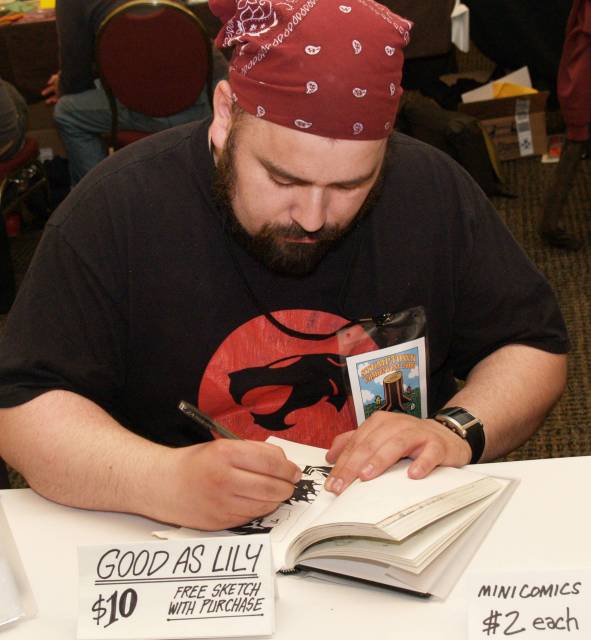
In his final column for Comic-Con International’s Carousel, Jesse Hamm wrote a smart, insightful tribute to artist John Paul Leon:
Social media quickly filled with praise and laments from comics fans and professionals alike. If there had been any question of his greatness, it was firmly answered by the outpouring of appreciations by many of comics’ top luminaries. Clearly, he was an Artists’ Artist, revered by the best in the field.
Hamm, who passed away suddenly on the morning of May 12, 2021 at the age of 45, couldn’t have written a better epitaph for himself.
Born in northern California, Hamm moved up and down the state during his childhood.
“I think that’s part of why he was so affable and easy to approach,” says his wife, fellow artist Anna Sahrling-Hamm. “He was very used to making new friends.” By the time he graduated from Union City’s James Logan High School in 1993, Hamm was a fixture in the local comics community, regularly visiting stores like Sacramento’s Comic Stop and conventions like Oakland’s WonderCon.
A year after his high school graduation, Hamm was diagnosed with acute promyeolocytic leukemia, which required him to undergo an autologous bone marrow transplant at the University of San Francisco Medical Center. Family members credit his positive attitude and Christian faith with getting him through treatment. His aunt, Rosanne Peterson, recalls nurses using the art he drew to decorate the pediatric oncology ward.
“Those treatments took a lot out of him, and took a real physical toll on him,” says comics retailer and longtime friend Tim Goodyear, “but they brought out this amazing resilience in Jesse. When the chemo weakened his right arm, he taught himself to draw left-handed, just in case he didn’t regain his full strength.” In later years, artists recall Hamm showing off this skill by drawing simultaneously with both hands.
After completing his medical treatment, Hamm joined the northern California self-publishing scene in earnest. Through conventions, artist get-togethers, and supportive comic book shops, the Bay Area’s small press scene thrived in the late 1990s and early 2000s, and Hamm found himself at the center of the local self-publishing movement. “The self-publishing scene then was huge,” says cartoonist Jimmie Robinson. “It’s nurturing to be among a supportive community, and that was the Bay Area in the 1990s.”

At the Alternative Press Expo, Hamm sold his early minicomics, including 7 Seconds and a Dead Fish and Comics to Bore and Confuse You. “I first met Jesse at an Alternative Press Expo in the nineties,” says Gene Luen Yang. “It was the very first time I ever tabled at a con. He came up to my table, flipped through my portfolio, and saw a comic that I had done about faith. He also did comics about faith, so he invited me to hang out with him at an after party.
“There, he introduced me to a bunch of different creators, including Derek Kirk Kim. That’s how I became a part of the comic book community. Jesse Hamm invited me.”
Derek Kirk Kim also counts Hamm as his first real friend in comics. “Besides hitting it off on a personality level, his work was just as great a draw,” says Derek Kirk Kim. “It wasn't very common to run into someone starting out in comics with that level of craft...Honestly some of the best comics ever produced in mini form. It seems insane to me that these stories were never collected by a major publisher."
“This might surprise people because of his friendly nature,” says Kim, “but Jesse was pretty rebellious in a way. With his classical artistic chops, he could've made a pretty penny just doing superhero fan comics or something, but he was determined to produce really unique, dark, sarcastic work, commercial or not.”
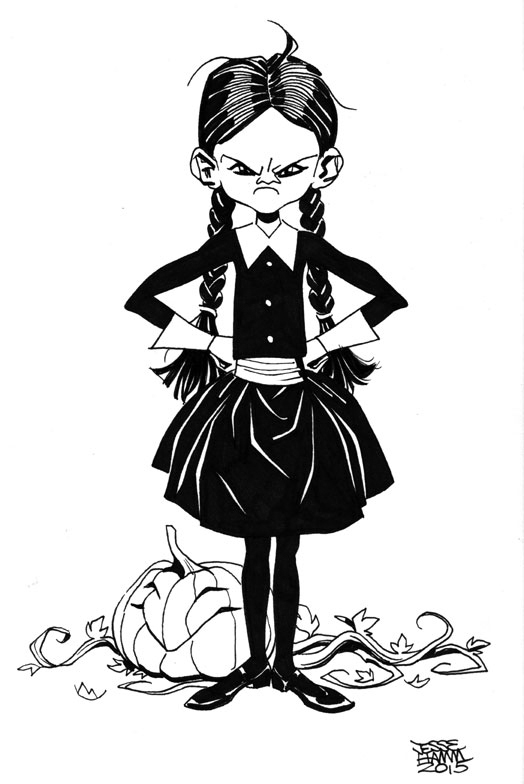
Hamm’s kind-hearted nature endeared him to every cartoonist he met in the late nineties and early 2000s, as he seemingly attended every Bay Area artist meetup. Jimmie Robinson met Hamm at a self-publishers’ event at San Francisco’s Cartoon Art Museum. “Artists were set up at folding tables along the side wall,” Robinson recalls. “Jesse was one of the exhibitors with his zines and random art sketches. After the event many of us got sandwiches at a nearby shop. That’s when Jesse opened up more and we told him about the meetings many artists in the area attended every month.”
Through those meetings, known to attendees as Art Night, Hamm met local creators including Robinson, Greg Espinoza, and Shepherd Hendrix, all of whom offered him practical advice about self-publishing as well as much-appreciated camaraderie. “Sometimes we’d meet at the house of creator, or we might all meet at a café or coffee house. It was always rotating,” says Robinson. “It wasn’t until the late 1990s and early 2000s that the location became stable at Jason Shiga’s house. At that point Jesse was a main fixture.”
Jason Shiga’s weekly Art Night gatherings provided up-and-coming cartoonists the opportunity to socialize and learn from each other. Among the regular attendees were Hamm, Derek Kirk Kim, Lark Pien, and Gene Luen Yang. “Like everyone, I was just blown away by his natural talent,” recalls Shiga. “He seemed to be working at a level beyond any of us [at Art Night]. He didn't go to art school; he was completely self-taught. He was incredibly fast as well. I remember I once had the opportunity to guest edit an all comics issue of Youth Outlook. So of course, the next Art Night rolls around and I told the gang if any of them would be interested in contributing a comic, the deadline would be at the end of the month. Jesse sat down and created a full-page comic on the spot within the span of about 30 minutes, straight to inks.”

Yang was also impressed by Hamm’s comics expertise. “Even in his early twenties, Jesse had a wealth of knowledge about comic books. After he passed, I went through my email box and I found critiques he had given me for American Born Chinese and Level Up, two graphic novels that were eventually published by First Second Books. He was a part of my inner circle of early readers back then. I really relied on his wisdom, his knowledge, his generosity.”
“Jesse brought people together, like it was a superpower,” recalls Tim Goodyear. “I could never thank him enough for introducing me to all these incredible people, and he just did that with everybody. If you were into comics, if you were really into comics, Jesse recognized that, and he took you in.”
Goodyear, likewise, would do his part to introduce Hamm to like-minded northern California cartoonists, like DC Comics newcomer Ryan Sook. ”I met Jesse when Tim Goodyear brought him by my place in the late nineties, ‘98 or ‘99, somewhere in there. I had just started working in comics and had no idea what I was doing,” says Sook. “I met Jesse who was trying to do comics professionally and he actually DID know how it was done. I knew that right away. I learned some interesting things from him as we discussed artists and art and storytelling and I was shocked that a guy that was as insightful about our field and extremely talented was struggling while a novice like me was getting work. I didn’t understand it then and I’m not really sure I do now. But I knew immediately that he was a genuine person with a ton of integrity and kindness and that spoke more than even his wonderful drawings.”
Sook and Hamm bonded over their love of comics, but more than that, says Sook, it was their faith that cemented their friendship. “I thoroughly enjoyed talking to Jesse about God and religion. We may have spent more time on that than comics, actually. Comics was his craft and he loved it, but who he was, at least in my short experiences with him, was a man of faith. That was where he was anchored in life. His moral integrity made it difficult for him sometimes to accept certain kinds of comic work that was available to him, but he had a line drawn that was bolder than any ink or pencil he ever laid down that made those struggles worthwhile.
“I found him to be a godly man. Unflinching in his beliefs. That he could disagree with someone whole heartedly, retain his integrity, and still treat them with respect and care and love…that is a greater testament to who Jesse is to me, than any of the comics he ever made. But even his comics were full of that. He didn’t just teach us how to tell stories, he was teaching people how to live.”
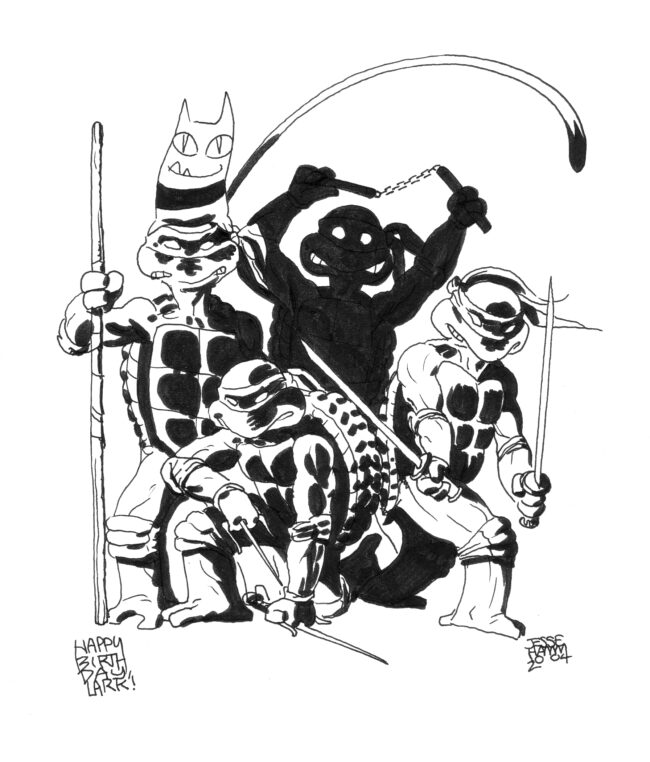
Steve Lieber, who shared a studio with Hamm for more than five years, knew that Hamm’s faith was a core component of his identity, but also that it was a topic that he only discussed with those who initiated that conversation with him. “I know his faith was important to him, but he kept that part of his life entirely separate from his secular friends,” says Lieber. “I read a quote of his from a Christian comics message board which was about Christian art, but seemed to describe him as well:
An interesting difference between contemporary Christian art and atheist art is that the latter proceeds from its assumptions rather than defending its ideas propositionally, and I think it’s more effective as a result. I think that principle is why cathedrals and Christmas carols are more effective than Chick tracts at turning our minds toward God.
Although Hamm only occasionally explored religious themes in his comics, he refused to draw material that went against his faith or his personal moral code. “He’s Peter Parker, really,” says Goodyear. “He has his moral line, and it’s SOLID. He passed up many scripts over the years because they would have required him to draw something that he found morally objectionable. I didn’t always agree with those decisions, but always respected him for that.”
“He was religious and didn’t care what our more liberal friends thought of his beliefs,” says cartoonist Wahab Algarmi. “He was very matter of fact about it. Everyone was nice enough to him about it, but he didn’t hide it, either. His beliefs were his and he let it be known if need be...there was a bluntness to Jesse.

That bluntness made Hamm a memorable presence on comic book message boards in the early 2000s, as he never shied away from offering his opinions to other fans and his fellow artists. Through long, back-and-forth discussions online, Hamm honed his writing style and established himself as a true authority on comic book art and storytelling. “I don’t think I know anyone with a higher Comics IQ than Jesse,” says Gene Luen Yang. “He was an incredibly smart guy, and he was incredibly passionate about comics. He thought deeply about this medium that we all love.”
“I admired him right away,” says Anna Sahrling-Hamm, who met Hamm through a Christian Comic Book Artists message board while she was living in her native Sweden. “I remember sending him an encouraging email when he was going through some rough times, but it was a while before we started chatting privately. And when we did hit it off, we couldn’t stop chatting. Our phone and internet bills were through the roof. He was so fun, so sweet, so kind and so smart, so easy to talk to.”
Hamm flew to Sweden to meet Sahrling and her family, then she visited his family in Lodi, California. After Hamm proposed, they continued their long-distance relationship until they were able to marry.
“He proposed on December 23, 2001, by a lake not far from our house,” says Sahrling-Ham. “I remember it was brutally cold, with a thick layer of snow. I think there were a couple of swans. It was lovely, even though we were freezing to death.
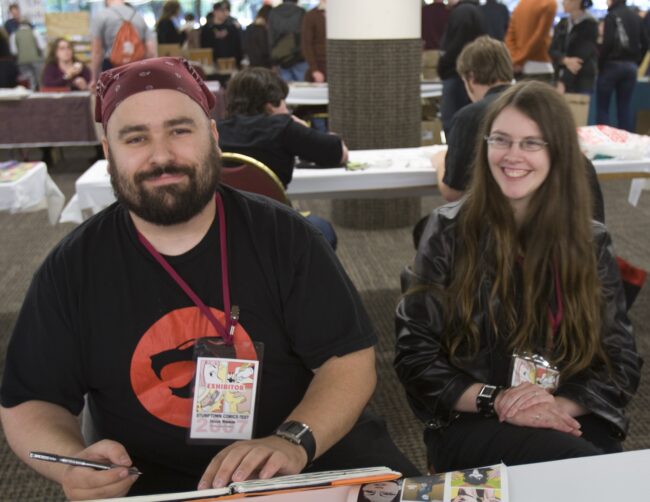
Meanwhile, Hamm had begun publishing comics online. He was one of the first artists recruited to join the online comics collective Modern Tales in 2002. The website’s founder, Joey Manley, scouted the Bay Area for talent, and artist after artist recommended Hamm. On Modern Tales, Hamm serialized Bitten Apple, his offbeat retelling of “Snow White,” which had been a recurring feature in his minicomic series Savage Daisies. Bitten Apple ran on Modern Tales for several years, but Hamm stopped drawing it just a chapter or two before its planned ending.
“I was always sad he never finished Bitten Apple,” says fellow Modern Tales cartoonist Jason Thompson. “As far as I know that was his longest work as a writer-artist, and it had the same cruel-funny satiric energy as Comics to Bore and Confuse You. I kept bugging him to finish it in what I only later realized was a very obnoxious, patronizing way. Looking back with more maturity, I now assume he must have decided that the fundamental premise or plot of Bitten Apple was flawed in some unfixable way and that's why he set it aside.”
Whatever the reason, Hamm shifted his online presence away from serialized storytelling and toward comics scholarship and craft. On his LiveJournal blog, he posted in-depth appreciations of his favorite comic artists, usually classic naturalistic illustrators. His passion for lesser-known artists like Jesse Marsh and Garrett Price helped new readers discover their work, and in some cases his research and his impressive collection of rare publications facilitated modern-day reprints of comics arcana.

After Hamm’s mother, a great supporter of his comics career, passed away, he inherited a home in Gresham, Oregon, a small city immediately east of Portland. Hamm married Anna Sahrling in the summer of 2005, and, following a six-month period as her immigration papers were finalized, the two made a home together in Gresham.
“I didn’t realize it at the time, but Jesse’s move to Portland really was the end of an era,” reflects Yang. “Now that he’s gone, I realize how important he was to me. When I think of my years in the independent comics scene of the ‘90s and early 2000s, I have lots and lots of fond memories. Jesse’s in nearly every one of them.”
While the move from California to Oregon was not without challenges, Hamm’s reputation preceded him, and he was welcomed by Portland’s bustling comics community. Steve Lieber recalls inviting him to visit Mercury Studio, a studio space shared by several comic artists. “He'd come by to use the scanner, and hang out and talk about art, and to sit in on the life drawing sessions we used to host. We encouraged him to keep visiting. He did! Soon he was assisting on a bunch of comics and commercial art jobs.” Hamm officially joined the studio in 2007, when it expanded and rebranded as Periscope Studio. The studio continues today as Helioscope.
Portland had its own “Art Night” scene, and soon Hamm was again attending weekly comics drawing sessions where he would work and talk shop. “When I landed in Portland in 2005, I started up a weekly comics hangout night at my apartment and just sort of demanded that everybody in town show up,” says Helioscope member Dylan Meconis. “Jesse brought Anna along as soon as she arrived in the U.S.
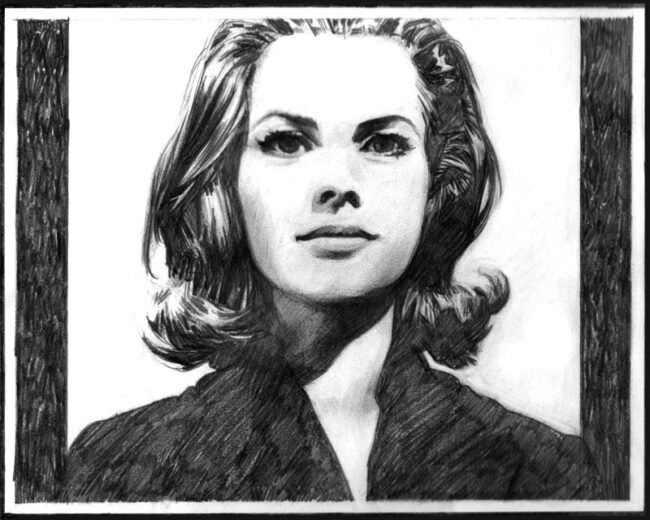
Hamm’s easygoing nature and sense of humor made him an ideal studio-mate. “Jesse was perfect in a group setting like that,” recalls Helioscope member Jeff Parker. “He’d mostly be working away so quietly you’d barely realize he was in the room as everyone chatted, but he was always taking in everything and waiting for the right moment to put us in hysterics with a snappy interjection.
“For a while we had ‘The Point Board’ on the wall with all our names in rows and we gave plus-points for a particularly good joke and negative points in red for utterances that we agreed were in the ’too much, don’t go there’ category. Naturally everyone became more interested in running up red points but they all took a backseat to Hamm, he ruled that board. And in a tough room!”
Hamm’s first major comics project after his arrival in Portland was illustrating the graphic novel Good as Lily, written by Derek Kirk Kim. The book was published by Minx, an imprint of DC Comics designed to attract the teenage girl market that had driven the North American manga explosion of the 2000s.
Kim says, “It wasn't hard at all to convince the people at DC to hire him for that book! I just sent them a bunch of samples and it was a go. There were no other artists considered, as far as I can remember. I remember being so thrilled as every page came in. He brought so much energy and life to that story.”

Although Good as Lily was well reviewed, the Minx line struggled to find its audience and folded after a year. Some of Hamm’s colleagues feel he was pigeonholed as a YA artist at a time when YA graphic novels got short shrift from publishers. “Good as Lily showed editors Jesse could draw Good as Lily,” laments Tim Goodyear. “Here’s this unbelievable cartoonist, and here’s a world that doesn’t give him the right place to land.”
Hamm’s comics output over the last decade of his life, including a short story in Matt Fraction’s critically acclaimed Hawkeye series, Blessed Machine, a spiritual sci-fi miniseries co-written by Mark Rodgers, a Batman ’66 story written by Jeff Parker, and the five-issue miniseries Flash Gordon: Kings Cross, co-written with studio-mate Jeff Parker, reflects the unpredictable nature of freelance life. “Jesse had several opportunities come his way after that Hawkeye story,” recalls Goodyear, “but he didn’t even try out for some of them, because it would have required quitting his day job, which paid better than any of these comics would have. You could only do that so many times before editors stopped calling.”
Dylan Meconis, too, felt that Jesse was, to coin a phrase, trapped in a world he never made. “Jesse's work is, to my eye, too European to make commercial sense in the American market. He arrived in the industry in the late ‘90s, when American comics were basically a smoking crater. The only comics jobs that paid a living wage then were in superhero comics, and for all that he was fond of them, his art was just way too spare and kooky and craft-minded to thrive in the balls-out maximalism of ‘90s cape comics,” says Meconis.
“If he'd been working in the Silver Age, or during the height of commercial illustration a century ago, or in Belgium in the 1970s...but then we wouldn't have gotten all those devastating tweets or amazing Patreon posts. Maybe if he'd landed fifteen years later and busted onto the scene, he would've wound up in animation or become a popular online artist with a horde of Instagram followers. Talent and mainstream commercial success have so little to do with each other. It's just timing.”

Hamm’s day job involved commercial illustration for clients including Hitachi, Fox, and Target. The work was demanding and painstaking, but provided financial stability and, importantly to Hamm, allowed him to make a living as a full-time artist. “When he first moved up here, he told me fully expected to get a data-entry job and just draw for himself when he could make time,” recalls Lieber. “I think he was a lot happier earning a living at the drawing board instead, accumulating experience, using his remarkable skills, and trying new things. The Target job had plenty of annoyances, but it was lucrative and steady, and he liked getting paid to learn his way around the digital toolset. Before he took that job, he was skittish about digital drawing, but after a year full-time at the Cintiq, he was hooked on the freedom and precision.”
The demanding schedule from his commercial clients limited his time onsite at Helioscope, but whenever his workload permitted, Hamm set up shop at Helioscope, and was always willing to lend a hand drawing backgrounds, inking, and lending a hand any way he could to artists racing to meet their deadlines. And he was always generous with his time and expertise, especially to the studio’s younger artists. “My first impressions of him were a complex mix of respect and intimidation if I’m honest, a bit like a freshman hanging out with an upperclassman,” recalls Rich Ellis. “Jesse was a true master draftsman; everything about his work is considered, precise, and carefully executed, while simultaneously warm, dynamic, and expressive. Nothing makes a young artist sweat like knowing the person at the next table can glance at your table and tell you exactly where your perspective went wrong.”

“The thing was, if you asked him for help or advice you never regretted it. Jesse was a natural and articulate teacher, always excited to share his insight and knowledge. He was modest, and one of the most straightforward honest people I have known. He could explain a concept without making you feel lesser for your mistake. Paired with an encyclopedic knowledge of comic history he was a font of tips and recommendations. I quickly lost track of how many times I saw not just myself, but everyone in the room benefit from his skill and understanding.”
Dylan Meconis, who met Hamm at Comic-Con in 2002 while she was still a teenager, shares Ellis’s reverence for Hamm as both colleague and teacher. “The worst thing about having Jesse as a studio-mate was that he always used flawless, painstaking technical perspective rendering. Watching him set up all those vanishing points and guidelines, whether it was to chart out a complex image of a stadium full of bleachers or just a damn pair of handcuffs (SERIOUSLY, DUDE), made me uneasy by moral contrast. It made me feel like I was wolfing down a bag of Cheetos for lunch in front of a friend savoring a vegan salade composée made from ingredients they grew in their own organic garden.”
“The next worse thing was that he often kept vampire hours, or he worked from home to save himself the long ride in,” Meconis continues. “We were all happy every time he would quietly hustle in with sort art under his arm and a giant burrito in the other, give a stoic nod to anybody who looked up, and immediately hunker down at his desk. You'd think that was a sign he wanted to be left alone...but he perched at an enormous desk right in the middle of the busy front room, staring down the front door and the lunch table and with sightlines to the other rooms. He'd put on headphones if he really wanted to concentrate, but otherwise he was listening to everything and everybody, and would occasionally cackle at somebody's goof, or lance a deadpan interjection or a deep-cut comics reference.”

“In terms of his role in the studio's internal politics, he was profoundly chill. He'd let it be known if he really didn't dig something, but he never stomped out or made a fuss or left a mess in the sink, and he happily went along with our collective cockeyed schemes or jumped in on group jobs. He was curious to learn about the things that mystified him–digital art, social media stuff–and he was never somebody to dismiss wisdom just because it came from somebody of a different age or background or area of artistic interest. If he was skeptical of something, he'd ask questions in a way that was critical-minded but always polite and inquisitive.”
Hamm’s advice wasn’t limited to the friendly confines of Helioscope. Building on his earlier success as a blogger on LiveJournal, he embraced social media as a means of reaching a wide audience of professional and aspiring artists with his drawing tips, advice, and appreciations of his favorite illustrators. Through word of mouth from his fellow artists and regular viral posts and gag cartoons, Hamm built a sizable audience of 21,000 followers on Twitter and more than 200 supporters on Patreon. “I’m so glad he was able to get some of his wisdom out there through @Hamm_Tips [on Twitter],” notes Gene Luen Yang. “He really genuinely wanted you to get better because you’re his friend, you know? And also, he just loved comics. He really, really wanted to read good comics.”

“He put all that great advice out there, and he did it for free,” observes Tim Goodyear. “He cared so much, and comics were everything to him. He really admired the hungry, genius-type cartoonist, the kind of artist who was never complacent, and he really wanted everyone to do the best work they possibly could.”
“And Jesse’s ability to process comics, his comics literacy, that was just insanely high,” adds Goodyear. “Jesse could recognize qualities in comics that others didn’t. He could take any comic, American, European, any comic, and he could study it, break it down, and explain it to you in a way that you’d never thought of before. No one else worked on that level."
Steve Lieber agrees, wholeheartedly. “I've said for years in a bunch of places that when it comes to writing about the art and craft of drawing comics, Jesse is the best there is. I've never seen anyone else come close. No one. When I wrapped up my tenure blogging about the same topics at Comic Con International's website, I told my editor that he needed to hire Jesse, who would do the job waaaaay better than me.”
While Hamm’s writings on comics were accessible to newcomers, his most dedicated readers were comics professionals, including Will Eisner Hall of Famer Dave Gibbons. “I didn’t know Jesse personally but felt he was very much a kindred spirit, fascinated as he was by the processes of drawing and telling stories visually. I was pleased to support his Patreon account and was always excited to read each new essay from him. His is a loss not only to his family and friends but to the world community of comic art, which he always sought to develop and enrich. We will all miss him.”
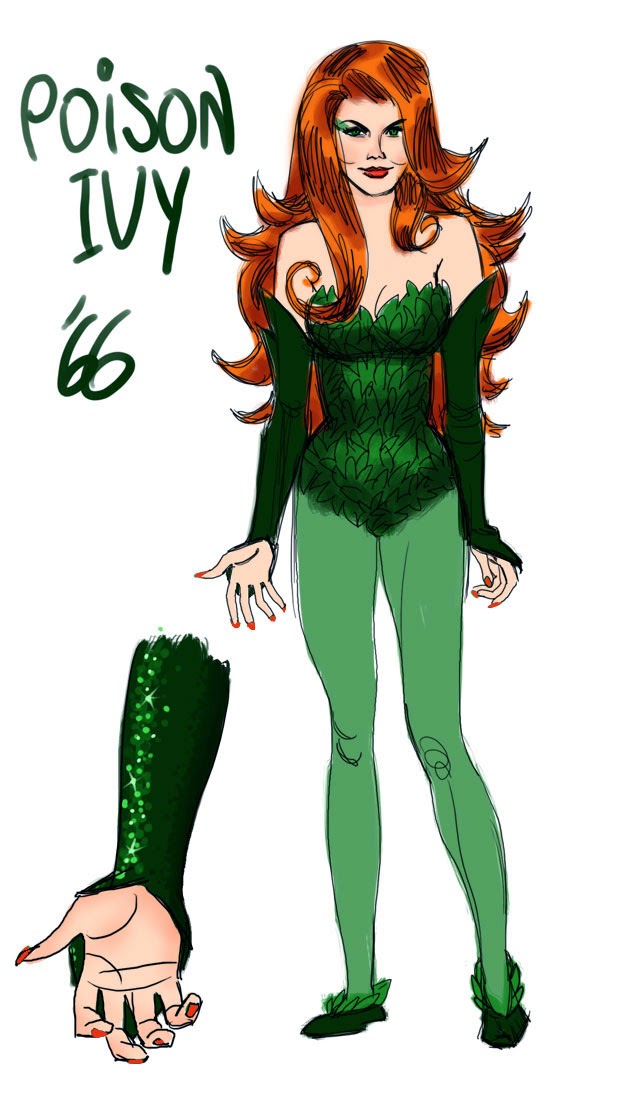
“He was a high priest in the church of comics,” Derek Kirk Kim observes. “Here's an anecdote that might be kind of illuminating—Jesse was very critical and picky of the stories in comics. In fact, I knew very few comics he actually liked for the STORY. Most comics he liked purely for the art. So I asked him one time, why even bother with comics, why not just delve into pure art books instead? And he said simply, ‘Because it's not comic book art.’ To Jesse, the art of cartooning was the highest form of art.”
At the time of his passing, Hamm had started the process of compiling his Tips from Jesse Hamm column and other writings for a collected edition. A paperback edition of these online lessons, along with new and supplemental materials, was a book that Hamm’s friends and followers had been requesting from him for at least the past decade. “Part of why I'm so furious at Jesse dying right now is that it felt like, with Hamm Tips, he'd arrived at something that was uniquely, authentically Jesse–not Jesse in service of somebody else's creative or commercial agenda,” says Dylan Meconis. “It brought out so many of his skillsets and passions at once, that didn't depend on gatekeepers or mass appeal, but still put money in the bank. I think we were all just checking our watches for the announcement of a Hamm Tips book deal. I'm pissed. I'd like to speak to the manager.”
Rest in peace, Jesse Hamm. Friend and scholar, and an integral part of the Bay Area comics scene of the late ‘90s, the webcomics scene of the early 2000s, and the Portland comics scene from the mid-2000s onward.
“Clearly, he was an Artists’ Artist, revered by the best in the field.”

* * *
An additional selection of memories and tributes can be read here.






